This was published 3 months ago
Red-light therapy. Cryotherapy. Hyperbaric chambers: The race to stay forever young
Want to live 20, 30, 50 years beyond the norm? Some with wealth and ambition are eagerly pursuing that dream to the extreme.
By Tim Elliott
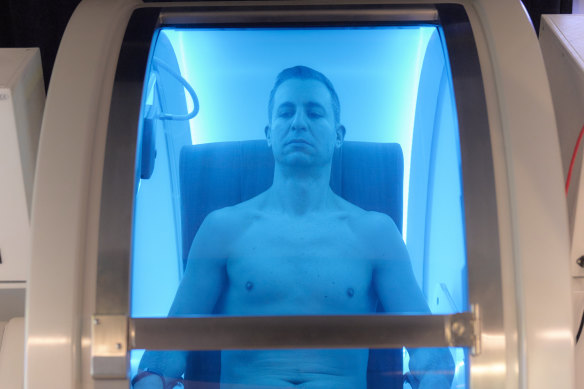
Tech entrepreneur Tristan Sternson relaxes in a hyperbaric chamber at Super Young, his life extension centre in Melbourne’s Armadale.Credit: Josh Robenstone
So we’re sitting in Tristan Sternson’s blood-red Ferrari Portofino, stopped at traffic lights in Armadale, in Melbourne’s affluent south-east, when he starts telling me about how he was in Los Angeles recently – discussing stem cell transfusions with his longevity doctor. Sternson goes to Los Angeles quite a bit, for longevity treatments that aren’t available in Australia, including stem cell therapy. His doctor, a charismatic and entrepreneurial physician called Deep Bhasin, floated the idea of inhaling stem cells via a nebuliser, which he claims is great for repairing age-related damage to the lungs. In the end, however, Sternson opted for an infusion.
Two days later, he had 100 million stem cells delivered via an IV drip into his right arm, followed by 85 billion exosomes, nanoscopic vessels that help transport proteins and which are thought to trigger potent regenerative properties. The treatment, which took place at Dr Bhasin’s Encino clinic, near Hollywood, took 2½ hours and cost $US12,000 ($17,500). “Afterwards, I was so jacked up that I had to walk up and down Sunset Boulevard to burn off energy,” Sternson says.
It was his fourth such infusion in 18 months, each of which necessitated a trip to LA. But he swears by it. “My chronological age is 44, but my biological age is 34,” he says. (Some say biological age can be measured by the length of your telomeres, protein structures that protect chromosomes, and which shorten with age.) “Now when my birthday comes up, my kids are like, ‘Do you mean your biological birthday or your chronological birthday?’ ”
Sternson, who lives in Brighton, is one of Australia’s most successful tech industry entrepreneurs. In the past 10 years, he has built and sold three technology businesses, mostly in data and analytics, for almost $400 million. He is now the global co-lead of NCS NEXT, a multinational IT company based in Singapore. He has short dark hair, a boyish build and a nebbish self-consciousness that is, notwithstanding the Ferrari and Master of the Universe bank account, hard not to like. Growing up in Doncaster, in Melbourne’s north-east, he was an elite athlete, and competed in triathlons from the age of 13. In 1997, he represented Australia at the Maccabiah Games in Tel Aviv, and was standing on the footbridge over the Yarkon River when it collapsed, resulting in the deaths of four Australian athletes. Ever since then, his overriding modus has been optimisation through analytics, an approach he’s applying to his most recent and ambitious project, which is to radically extend his lifespan through whatever means possible, short of becoming a cyborg.
Sternson’s transformation began, inevitably, with a midlife crisis. It was 2019, and he was in LA for business. “My 40th birthday was coming up, which was a big deal for me,” he says. “I went from feeling invincible to feeling more vulnerable.” And so he decided to have his bloods tested. “I did 48 different markers – hormones, liver, cortisol, inflammation, kidneys. Everything.” Much to his shock, one of his tests showed he was pre-diabetic. “I had to do something,” he says. This being LA, a colleague suggested cryotherapy, an experimental treatment that involves being briefly exposed to sub-Arctic temperatures, and which is said to reduce inflammation and boost immunity. His first session, which he underwent at Upgrade Labs in Beverly Hills, involved standing in gym shorts only for 2½ minutes in a full-body breathable nitrogen chamber at minus 140 degrees. “It was amazing,” he says. “I came out feeling full of energy and stress-free.”
Back in Melbourne, he began researching other cutting-edge therapies. “I became a citizen scientist,” he says. “I read a lot, listened to podcasts, joined chat groups and went to conferences.” He began consuming an array of longevity supplements and protein shakes, and having regular injections of a coenzyme called nicotinamide adenine dinucleotide (NAD), which has been shown in some studies to improve DNA repair and cellular ageing.
In early 2024, he opened a life extension centre, called Super Young, in Armadale, and stocked it with the kinds of space-agey, health-enhancing hardware he could only previously enjoy in the US, including a full-body cryo fridge, two hyperbaric chambers – which use high atmospheric pressure to help the lungs take in more oxygen – and something called a TheraLight 360, a coffin-shaped machine that you lie in, naked, while being bathed in red and near-infrared light. There are also several PEMF mats, which look like thin inflatable sleeping mats and are supposed to improve cellular health by pulsing electromagnetic waves through your body at precise frequencies.
‘It’ll be common to live well over 100. Believe me, this is going to change everything.’
Tristan Sternson, tech entrepreneur
The clinic now has 230 members, each paying between $85 and $289 a week. But you get the impression Sternson built it for himself as much as anyone. He’ll often come here to hang out, take in some red-light therapy or clock an hour or so in the hyperbaric chamber while answering emails on his phone. He has also developed a number of everyday biohacks, most of which are focused on cognition. For an hour every morning, he wears a neuro-stimulator, a tiny electrode that he clips to his left ear, which purports to rewire your nervous system by delivering small, targeted electrical impulses to the brain. He often drives to work via a different route, to make sure his mind “doesn’t go into autopilot and get lazy”. (“Although I do end up in the wrong place a bit.”) And he’ll switch computers in the middle of the day, from a Mac to a PC, to encourage brain plasticity. He also takes an ice bath first thing every morning, for four minutes at four degrees, and makes sure to walk around barefoot for at least 15 minutes a day to connect with the earth’s natural electrical current.
If he wasn’t such a smart guy, you would think he was a lunatic – not that those two things are mutually exclusive. In any case, he’s convinced that mankind is on the cusp of an epochal change. “I believe that if you live for another 10 years, there will be medications and research that will allow us to live over 100. In fact, it’ll be common to live well over 100.” He glances at me sideways, like he’s giving me a stock tip. “Believe me, this is going to change everything.”
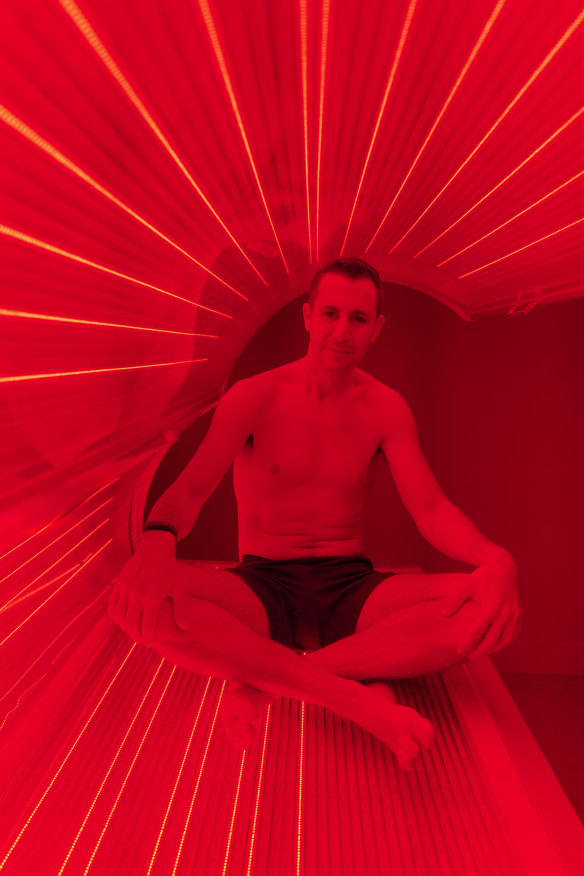
Super Young founder Tristan Sternson receiving red-light therapy.Credit: Josh Robenstone
Life extensionists are generally thought of as people who want to push their lifespan beyond the accepted limit, which, in the developed world, is about 122 years, a record set by a French woman, Jeanne Louise Calment, who lived from 1875 to 1997. But life extension is more than just extending life. It is, depending on what angle you turn it, a social movement, a science experiment, a philosophy, an intellectual pursuit and a business opportunity. It has in the past 30 years gone from the fringe to the quasi-mainstream, pushed forward by a loose coalition of scientists, intellectuals and activists, championed both by the ravenously curious and seemingly delusional; by those who think it’s perfectly reasonable to want an extra 30 years of life and by “immortalists” who believe death should be entirely optional.
“It’s a broad church,” says Aubrey de Grey, a biologist and gerontologist based in San Francisco. De Grey, who is 61, has been talking about life extension since the late 1990s. With his long, Gandolfian beard and proclivity for TED Talks, he is one of the movement’s most recognisable faces, and is thought by many to be its intellectual author. Originally a computer scientist, he spent the late 1980s researching AI before realising what he calls “the bleeding obvious, that ageing is the world’s most important problem. I also realised that the people who should be doing something about it, namely biologists, weren’t interested. And so I thought, f--- it, I’ll do something!”
With help from his wife, a fruit fly geneticist named Adelaide Carpenter, he taught himself biology with a focus on gerontology, the science of ageing. In 2000, he organised a day-long roundtable at the Children’s Hospital Oakland Research Institute in California with eight scientists, including some well-respected gerontologists. The participants emerged upbeat, concluding that science and emerging technologies might be able to reverse ageing in mice within 10 years, and that the same might be done for humans within another few decades. (Science hasn’t yet reversed ageing in mice, but de Grey says that is because of a lack of funding.) The way to get there, according to de Grey, was to implement what he called SENS, or “strategies for engineered negligible senescence”.
SENS essentially boils down to regenerative medicine. “The idea is that you can use preventative management to restore structure and composition at a molecular and cellular level.” His favourite analogy is vintage cars. “Why do 100-year-old cars exist today? They were built to last 10 years, 50 years at the most. But the reason they are still going is because of preventive maintenance. They have the rust scraped off and things like that. The human body is an infinitely more complex machine, but the principle is the same.”
In 2003, de Grey and the American philanthropist and entrepreneur David Gobel started the Methuselah Foundation, named after the Biblical figure whose lifespan was recorded in the Book of Genesis as 969 years. (It was previously known as the Performance Prize Society.) The foundation, which has the declared mission of “making 90 the new 50 by 2030”, sponsors prizes and funds longevity start-ups and research. In 2015, it funded a team led by Joao Pedro de Magalhaes, a Portuguese molecular biologist then at the University of Liverpool, to sequence the genome of the bowhead whale, which can live more than 200 years and is one of the longest-lived mammals on earth. Tissue engineering has also been a part of the foundation’s focus: it has put money into organ donation and awareness, and sponsored a prize for the first team that can create a bioengineered liver.
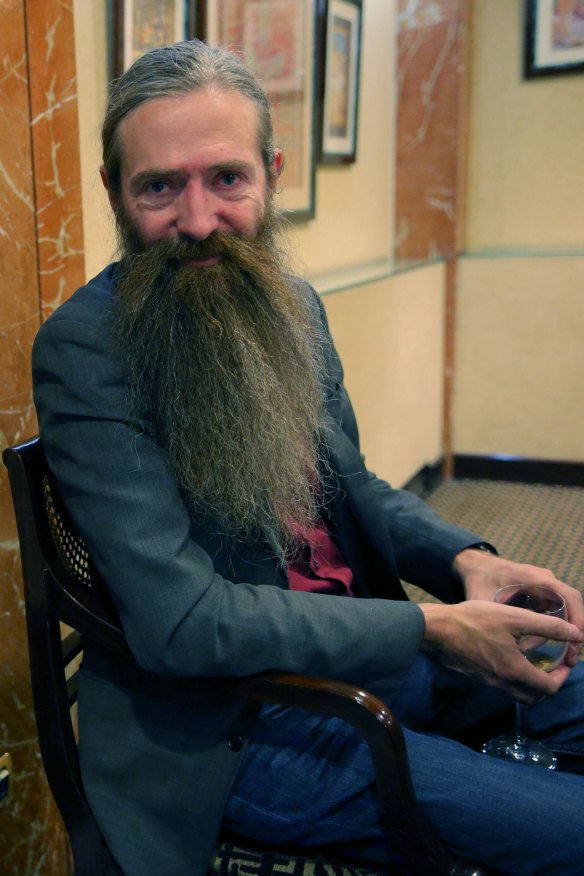
Life-extension guru Aubrey de Grey has been involved with the movement since the 1990s.Credit: Alamy Stock Photo
Despite the fact it’s named after a mythical person whose place in history owes to what is clearly an absurd fiction, the Methuselah Foundation has done much to legitimise longevity research. “When I first got involved, the anti-ageing industry wasn’t built on proper science, but that’s changed,” says de Grey. (In 2009, he left the Methuselah Foundation to start the SENS Foundation.) The Methuselah Foundation has since partnered with NASA on projects, including one in 2016 to create metabolically functional, vascularised organ tissue, and on the Deep Space Food Challenge, in 2021, to help develop new ways of feeding astronauts during months- or years-long space missions.
Such initiatives are diverse, but they are all leading to what de Grey calls longevity escape velocity (LEV). LEV happens when science can rejuvenate people enough for them to continue living until the next groundbreaking piece of science, which will enable them to continue living until the next even more groundbreaking piece of science, and so on, at which point we will reach “the Methuselarity”. He now believes there is a 50-50 chance we will get to “the Methuselarity” by 2036. He can’t wait. “I look forward to it, not so much because of the longevity itself but because of the indefinite youthfulness, which will give longevity as a side effect.”
For a long time, life-extension research subsisted on donations from wealthy eccentrics. But the past few years has seen a surge of investment from Silicon Valley tech titans, for whom eternal youth has a uniquely messianic appeal. (Once you’ve banked your first hundred billion and launched rockets into space, disrupting death is the next logical step.) In 2021, Sam Altman, chief executive of Open AI, poured $US180 million into a start-up called Retro Biosciences, whose aim is to add an extra decade to the average lifespan. The same year, backers including Amazon’s Jeff Bezos put $US3 billion into Altos Labs, a life extension biotech in San Francisco. Peter Thiel, co-founder of PayPal, has donated to the Methuselah Foundation, and helped fund a Silicon Valley start-up called Unity Biotechnology, which is creating therapies that target senescent cells, a major cause of ageing. (Thiel has said he wants to live to 120 and has signed up to be cryogenically frozen, so he can be brought back to life at some later stage.)
In 2019, German billionaire Christian Angermayer co-founded the excellently named Rejuveron, a longevity start-up incubator, in Zurich. “I am very confident that we will extend human lifespan within my lifetime to such an extent that we will voluntarily decide to exit this life and see what’s next,” Angermayer writes on Rejuveron’s website.
‘My biomarkers were already competitive with an 18-year-old’s.’
Bryan Johnson, entrepreneur and venture capitalist
For Angermayer and his ilk, life extension sometimes seems to be just another way to win. “I am the most measured person in history,” entrepreneur and venture capitalist Bryan Johnson tells me via a Zoom call from California. “My biomarkers show that I am in the top 1 per cent of the population in terms of health.”
Johnson, who is 46, founded Braintree Venmo, a web payment systems company, in 2007; in 2013, he sold it to PayPal for $US800 million. He is now said to be worth $US400 million. In life-extension circles, he is revered for his self-experimentation. In 2023, he injected himself with a litre of plasma from his 17-year-old son. On the same day, he passed on a litre of his own plasma to his 70-year-old father. Johnson claimed it reduced his dad’s age by 25 years. “I personally stopped doing it because my biomarkers were already competitive with an 18-year-old’s,” he tells me, somewhat smugly.
Johnson may be incredibly fit, but he is also one of the reasons life extension gets a bad rap. His skin has a disconcerting jaundiced tinge to it, and when he smiles, which is rare, it is like his mouth is being told what to do by a computer chip in his head. People openly speculate online about him having OCD. And he has a tendency to talk like a Bond villain. “Four years ago I imagined being present in the 25th century,” he tells me. “Today, we look back at the 15th century, and it’s obvious what they were doing right and what they were doing wrong. And so I thought, ‘What would the 25th-century people think we were doing right and wrong?’ And I concluded that they would say we were evolving from die to don’t die. ‘Don’t die’ would be the one political, economic, moral and ethical system of humankind. And that’s the goal.”
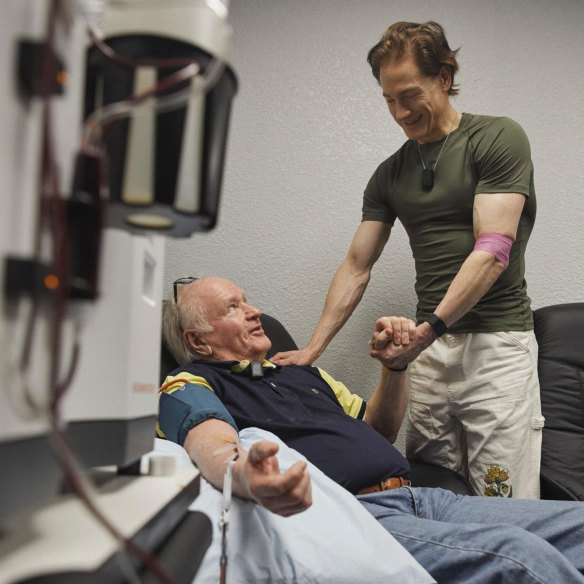
Entrepreneur Bryan Johnson giving his dad his own allegedly rejuvenating plasma.Credit: @bryanjohnson_/Instagram
After my visit to Tristan Sternson at Super Young, I drive across town to Melbourne’s other fountain of youth, a private anti-ageing wellness club called Saint Haven. Founded by property developer and businessman Tim Gurner, Saint Haven opened in inner-city Collingwood in 2023, with an emphasis on exclusivity: potential members must submit to a five-stage interview process and be willing to pay $23,000 a year. (Member numbers are confidential, but according to the culture guide Concrete Playground, at one point Saint Haven had more than 15,000 people on the waiting list. Gurner is in the process of launching two other Saint Havens, in Toorak and South Yarra, and a third club, simply called Saint, which will cater to a slightly younger crowd.)
I arrive at 2pm and hang around outside the building for a while, unable to find the entrance. I’m wondering if this is some sort of IQ test before a kindly member appears, leads me to a portal hidden in a small alcove off to the side and buzzes me in.
I am immediately approached by a man who introduces himself as Mark. Mark is tall, with a shaved head, and dressed in white, loose-fitting linens. He is strong-looking, in an Übermensch kind of way, and solicitous to the point of being vaguely menacing. “You’re a surfer, right?” he asks. Yes, I reply. How did you know? “Because I’ve been looking at your Insta page. Researching potential members is a big thing for us,” he explains. “We check out if they have the character that Saint Haven wants. We’re looking for good, humble human beings, because this is about social wellness as much as anything.”
‘So, how old do you want to live?’ Eugene asks. ’100…120, 130?’. He smiles and says, ‘Tim Gurner wants to live to 500,’ which I think is a joke but can’t be sure.
It’s also about comfort and luxury. Every aspect is curated for maximum, Queen Cleopatra-level pampering. The scented towels in the fridge on the wall of the gym, the mood lighting, the ambient hush. After checking out the gym, Mark leads me up a long corridor of illuminated arches, called the Path of Life, to a large granite tub – the Fountain of Youth – where members can fill their drink bottles with mineral-infused, reverse-osmosis water from a slender bronze pipe descending from the ceiling.
There are many different spaces here, including a meditation cave and massage rooms, a clinic for IV transfusions and several little nooks where people are undergoing speciality treatments. Privacy is paramount. Spaces are separated by sheer linen curtains. There are lots of candles, and in some rooms, grapefruit-sized balls of pink salt (to help with the humidity) and crystals (to collect negative energy). Contented-looking staff with numinous eyes and model-worthy facial structures hover about, also dressed in loose linens, offering various hydrating elixirs made of spices and herbs and raw honey. I’m thinking it’s all a bit culty when Mark, who can apparently read minds, turns to me and says: “I know, it’s all a bit culty.”
Mark hands me over to Eugene, a buff Kiwi with a gentle, caring energy, who leads me through a Fire and Ice treatment. We head to a room with a sauna (the “fire” component), where we sit basting in a soupy 90 degrees with two other sweat-slicked guys in budgie smugglers. “So,” Eugene says. “How old do you want to live? One hundred? Or do you want to push the ticket to 120, 130?” I tell him I just want to survive the sauna. He smiles and says, “Tim Gurner wants to live to 500,” which I think is a joke but can’t be sure.
After 20 minutes, we exit the sauna. I shower in vitamin C-infused water (for transdermal absorption). It’s now time for the “ice” component – a dip in a plunge pool at five degrees. I tell Eugene I have an acute fear, verging on hatred, of cold water. He gives me a little “you got this” pep talk, but that only scares me more. We then step down into the bath, together. By the time I’m up to my neck I am in a reality-distortion field of pain. Eugene is telling me to keep breathing, but I’m having trouble hearing him because I’ve pretty much dissociated and left my body. I endure this for two minutes. By the time I get out, I am numb from head to toe and staggering like Joe Biden.
From there it’s into the dry treatment rooms. I’m taken to a private nook and placed on a PEMF (pulsed electromagnetic field) bed, where I lie for 20 minutes as gentle birdsong is piped in through tiny speakers just above my head. This is followed by a spell of lymphatic leg compression, which is like having your legs rhythmically squeezed by those inflatable collars that your doctor puts on your arm to test your blood pressure. Eugene then takes me to the meditation cave (complete with full-sized brass gong), where he puts me through some breath-work – all good for stress and focus. I end the day with an infusion of assorted vitamins and minerals, including zinc and magnesium, and a shot of NAD in the upper left buttock. By the time I leave, I’m feeling good; not “I’m gunna live forever” good, but replete and well and content.
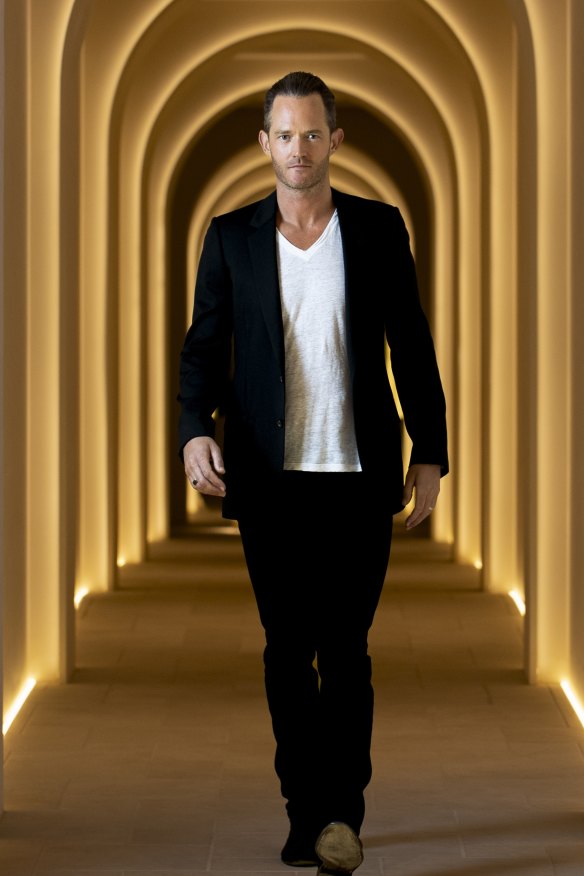
Tim Gurner at his anti-ageing wellness clinic, Saint Haven. Since his father died of cancer, his quest to live the best and longest life possible has become “an obsession”.Credit: Arsineh Houspian
I walk back out into the Melbourne streets, with their trams and traffic and filthy, non-UV-ozone-treated oxygen. After Saint Haven, it all seems so ugly. I head back to my hotel, where I lie on my bed and wonder what it would mean to live to 130, about what the world would look like by then, if my kids would be OK, and whether the constant effort required to extend my life would on some level interfere with the demands and tiny pleasures of daily life, and what that would do to my already woeful ability to live in the moment. This goes on for about 25 minutes, after which I go to the fridge, grab a beer and turn on the TV.
The following day, I catch up with Tim Gurner at his office on Malvern Road, in Prahran. Gurner, who is 42, greets me dressed in a black T-shirt, black pants and a black jacket, with his hair swept back, Gordon Gekko-style. He apologises for being a little late, explaining that he’s just come from a two-hour session with his spiritual healer.
Gurner is best known for his luxury residential and resort developments, and has a net worth of $989 million, according to The Australian Financial Review. He is a controversial figure. In 2017, he said that Millennials could afford their own houses if only they stopped splurging on coffees and avocado toast. Last year he told a property summit in Sydney that employees were insufficiently grateful to their bosses. “We’ve got to kill that attitude,” he said. “We need to see unemployment … jump 40, 50 per cent.” (He later apologised.) He was subsequently designated Australia’s plutocrat-in-chief, an image that his office, with its enormous marble fireplace and well-stocked bar, does little to dispel. Sitting down with him in person, however, I find him to be perfectly friendly and oddly unguarded.
“I started my first business, called My Well Being, in Earlwood, when I was 21,” he says. “It did yoga, massage, pilates and personal training. Six weeks after that, my dad died of cancer – multiple myeloma. It was absolutely horrible.” As a result, he became “terrified of dying”. Life ever since has become a quest “not to get sick and die. It became, ‘How do I live the best life possible with the least risk possible for as long as possible?’ ”
Gurner now describes this quest as “an obsession”. He receives a NAD injection every morning and takes 40 tablets daily, including boron, taurine, creatine and a number of peptides that he says were developed by the Russian military in the 1980s to protect their troops from radiation. He tracks every meal down to the gram and eats exactly 3300 calories a day. “The exact same numbers of fruits and vegetables,” he says. “It’s all brought to me here by the Saint Haven people.”
His home, which he shares with his wife Aimee and three young children, has circadian lighting, which mimics the colour of the sun throughout the day: orange first thing in the morning, yellow through the day, and then back to orange at sunset. To make extra sure he doesn’t inadvertently absorb any unnatural source of domestic illumination, he dons goggles with red lenses (to block blue light) from 7.30pm until the time he goes to bed. He then sleeps with a Chilipad under his sheets, which keeps the bed temperature at an absolutely optimal 18 degrees. Oh, and he tapes his mouth shut, to make sure he breathes through his nose while he sleeps. “Mouth-breathing is very bad,” he says. “It’s changed the structure of our jaws.”
I love all this; it’s so loopy. I imagine Gurner, lying in bed, his mouth gaffer-taped, looking like he’s been kidnapped. Or walking around the house with goggles on. He’s neurotic about detail: at one stage he shows me a graph with all his sleep data since 2019. But he is also, he says, a spiritual person, and very in touch with what he calls “the flow of life”. (He has the phrase “flow of life” tattooed in Morse code on his left forearm.) “It’s about not trying to control life too much,” he says, which, coming from a guy who tries to control everything from his caloric intake to his sleeping heart rate, is so cognitively dissonant it’s enough to give me an aneurysm.
Parking my disbelief just for the moment, I ask Gurner about the ethics of life extension. Is it fair to expend so much energy, resources and intellectual capital on extending the life of the most privileged while the needs of the less fortunate go unmet? “If we can extend everyone’s age by 20 years, that would be the best thing for the economy,” he says. “Twenty years more taxes and spending, plus all the savings you’d make in the health system. All those gains you could redirect to poverty alleviation.”
But don’t we have enough people on the planet already? “No, it’s the opposite!” he says. “Every country has a population crisis. Italy, Japan, even China. Their birth rates are right down.” I want to be a better journalist and combat this logic by saying that notwithstanding the veracity of the “population crisis” theory, it’s unlikely some peasant in rural China is going to get his own hyperbaric chamber and vitamin C-infused shower any time soon. But I’m exhausted. Perhaps I need a NAD shot. Sensing this, Gurner hands me a branded Saint Haven water bottle. “It’s hydrogen water,” he says. “Have you ever had hydrogen water?” No, I say. I don’t even know what hydrogen water is. “Oh, you’re going to love it then.”
Most life extensionists are keen to emphasise the science behind their therapies. Gurner told me that everything he does has been scientifically proven. But some treatments, such as NAD, have been proven to be effective mainly in rodents or fruit flies; others, such as PEMF, have shown promise mostly in short-term trials that are so small as to be clinically insignificant. Even the medical benefits of ice baths, popularised by the Dutch motivational speaker and extreme athlete Wim Hof, have little empirical backing, especially in terms of promoting longevity. That’s not to say you shouldn’t do them: if it makes you feel good and it’s not going to kill you, then take the plunge.
“People are desperate for the magic pills,” says Professor Luigi Fontana, a former co-director of the healthy longevity program at Washington University School of Medicine and currently the scientific director of the University of Sydney’s Charles Perkins Centre RPA clinic. “The claims behind these [life extension] therapies are based on hypotheses that are at best superficial or inaccurate and many times they are wrong and false.” According to Fontana, the best thing you can do to extend your life is to eat well and exercise regularly. Which is not what most of us want to hear.
When I think back to the treatments I had, the one that stays with me is some red-light therapy I had at Super Young. Oddly, this is the one I was most sceptical about. Still, there was something reassuring about being cocooned in a small warm space, the amniotic, blood-red glow leaking through my eyelids. I realised later that it reminded me of being in the womb. Safe, secure, at rest. I could have stayed in there forever.
To read more from Good Weekend magazine, visit our page at The Sydney Morning Herald, The Age and Brisbane Times.